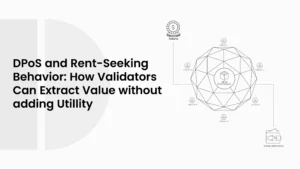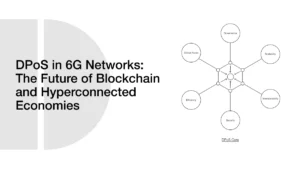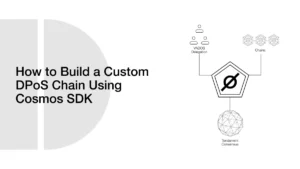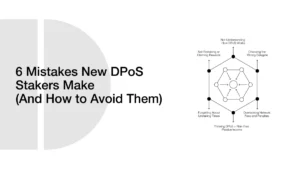Sustainability of DPoS in a Multi-Chain Future: Will DPoS Scale or Fade?
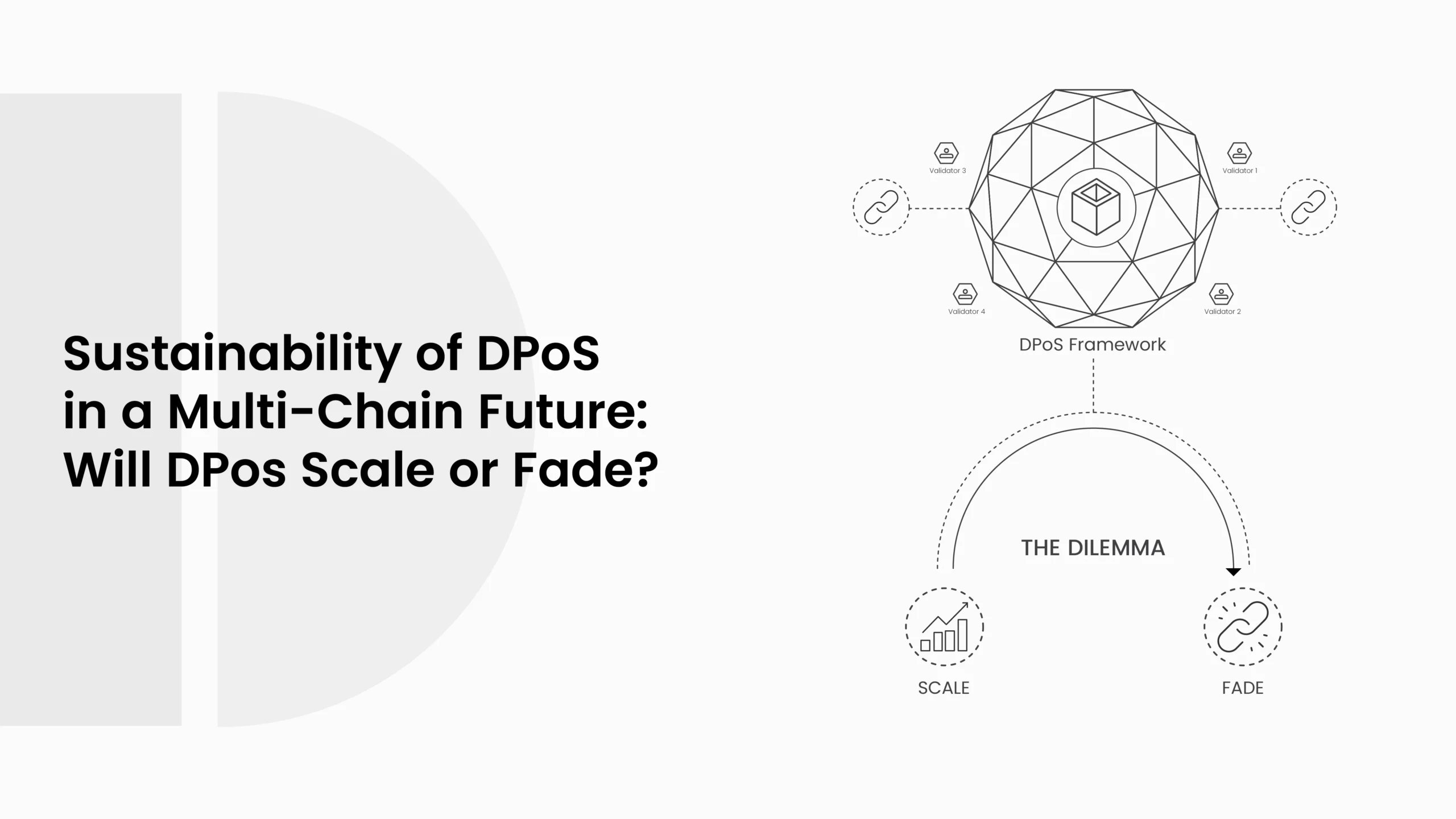
Blockchain is changing how money and data move around the world. Every blockchain uses something called a consensus system. This is the rulebook that decides how people agree on new transactions. Without consensus, the system cannot be trusted.
- Understanding Delegated Proof of Stake (DPoS)
- What is DPoS?
- Why DPoS Became Popular
- Limitations Seen Today
- Rise of Proof of Stake (PoS) in Blockchain
- PoS Basics in Simple Words
- Ethereum and the Shift to PoS
- Why PoS Looks Strong in a Multi-Chain World
- Multi-Chain Future: What It Means for Consensus
- What is a Multi-Chain Ecosystem?
- Challenges of Multi-Chain Sustainability
- Where DPoS Fits in This Picture
- Comparing DPoS and PoS on Key Factors
- Speed and Latency
- Energy Efficiency
- Governance and Participation
- DPoS vs PoS on Key Factors
- Sustainability of DPoS in the Long Run
- Environmental Impact
- Economic Incentives
- Political Centralization Risk
- Governance Risks of DPoS vs PoS in Multi-Chain
- Case Studies of DPoS Chains in 2025
- EOS
- TRON
- Steem and Hive
- Lessons from These Examples
- Examples of DPoS Chains in 2025
- Academic and Industry Views on DPoS Sustainability
- What Researchers Say
- Industry Opinions
- Why These Views Matter
- Research and Industry Insights on DPoS vs PoS
- Future Outlook: Can DPoS Adapt or Will It Fade?
- Possible Adaptations of DPoS
- Why PoS May Still Dominate
- Long-Term Predictions
- Conclusion: Will DPoS Scale or Fade?
- Frequently Asked Questions (FAQs) for Sustainability of DPoS in a Multi-Chain Future
- 1. What is Delegated Proof of Stake (DPoS)?
- 2. How is DPoS different from PoS?
- 3. Is DPoS better for the environment?
- 4. Can DPoS survive in a multi-chain future?
- 5. What are the risks of DPoS?
- 6. Why is PoS considered the future?
- 7. Will Delegated Proof of Stake disappear completely?
- Glossary of Key Terms
Over the years, many types of consensus have been tried. Proof of Work, or PoW, was first. It was secure, but it used too much energy. Proof of Stake, or PoS, came later. It removed mining and made the process faster and greener. Delegated Proof of Stake, or DPoS, was another idea. It gave more power to a small number of trusted delegates who manage the network on behalf of all token holders.
Today, blockchains are not only single chains anymore. People see multi-chain systems growing fast. These include ecosystems like Polkadot, Cosmos, and Avalanche. Multi-chain means many blockchains are linked together to share data and value. In such a future, the question is clear: will DPoS still have a strong role, or will PoS dominate because it is seen as more sustainable and fair?
This blog looks at the sustainability of DPoS in a multi-chain future. It will explain how DPoS works, why it became popular, and why it faces challenges now. It will also compare DPoS with PoS, especially on factors like energy use, decentralization, and governance.
Understanding Delegated Proof of Stake (DPoS)
What is DPoS?
Delegated Proof of Stake, or DPoS, is a type of blockchain consensus. In DPoS, people who hold tokens do not directly validate blocks. Instead, they vote for special members called delegates or witnesses. These delegates then take turns to confirm transactions and add new blocks.
The idea is simple. Instead of thousands of computers competing, only a few trusted delegates do the job. This makes the network very fast. Transactions can be confirmed in just a few seconds.
ALSO READ: Latency and Finality in DPoS: Why Speed Comes with Trade-Offs in Security
Why DPoS Became Popular
DPoS became popular because it was faster and cheaper than PoW. When it was introduced, people wanted a blockchain that could handle many users without waiting for long confirmations. Projects like EOS, TRON, and Steem showed how DPoS could process thousands of transactions per second.
Another reason for its popularity was cost. In DPoS, users do not pay high mining fees. Because the number of delegates is small, the process uses much less energy compared to PoW. That made it look like a greener choice when energy debates about Bitcoin and Ethereum were at their peak (Rukhiran, Boonsong, & Netinant, 2024).
Limitations Seen Today
Still, DPoS is not perfect. One problem is centralization. Since only a few delegates control the network, power is not spread out equally. This means that if a small group of people controls most votes, they can dominate decision-making.
Another problem is governance. In theory, token holders can vote out bad delegates. However, as a matter of fact, not all users vote. This makes it so that the same representational figures remain in power. This may minimize equity and be a result of politics within the network.
Even though DPoS is more energy-friendly compared to PoW, studies show that PoS is still more efficient overall. PoS does not need special delegates. Instead, it allows all stakers to secure the network directly. This makes it more inclusive while still being low in energy use.
Rise of Proof of Stake (PoS) in Blockchain
PoS Basics in Simple Words
Proof of Stake, or PoS, is another way blockchains reach agreement. Instead of using computers to solve puzzles like in PoW, PoS uses money that people lock up as “stake.” When someone stakes coins, they get a chance to validate blocks. The more coins they stake, the higher the chance they are chosen.
This makes PoS very different from PoW and even DPoS. It does not need mining machines, and it does not need a small group of delegates. Instead, anyone with tokens can join the process. The network picks validators randomly, based on how much of a stake they have.
This system conserves energy. There is no race to solve math puzzles. Validators just wait for their turn and prove they are honest by risking their stake. If they cheat, they lose money.
Ethereum and the Shift to PoS
The biggest change in blockchain happened when Ethereum moved from PoW to PoS. Ethereum called this “The Merge.” Before the Merge, Ethereum was one of the biggest energy users in crypto. After the Merge, energy use dropped by more than 99%.
This event showed the world that PoS was real and practical. It was not only about saving energy. It also showed that big blockchains with millions of users could run on PoS safely. This gave confidence to new projects to start directly on PoS instead of PoW or DPoS.
Studies also support this. Research by Rukhiran, Boonsong, and Netinant (2024) explains that new consensus systems like PoS make blockchains more sustainable. By removing high-energy use, they fit better with global goals of reducing carbon footprints and building greener systems.
Why PoS Looks Strong in a Multi-Chain World
Today, PoS is growing fast. Many big blockchains now use PoS, like Cardano, Solana, and Avalanche. These networks show that PoS can handle speed, security, and thousands of users.
One reason PoS fits better in a multi-chain world is flexibility. PoS systems do not require a small number of delegates to connect to sidechains, rollups, or other networks. It turns out that blockchains can more easily communicate with one another, and this is crucial to cross-chain transfers and shared apps.
Another reason is fairness. In PoS, every token holder can stake if they want. This opens the system to more people, unlike DPoS, where only a few delegates hold real power. A multi-chain future is all about cooperation, so systems that allow wider participation have an advantage.
Multi-Chain Future: What It Means for Consensus
What is a Multi-Chain Ecosystem?
The blockchain world today is not limited to one big chain. Instead, it is moving toward a multi-chain system. A multi-chain world implies that numerous blockchains are present simultaneously and are also able to communicate with each other. This relationship enables users to transfer tokens, data, and applications across different chains.
For example, projects like Polkadot and Cosmos are built with the idea of linking many chains together. They let developers create smaller chains, also called parachains or zones, and still connect them under one large network. This setup helps blockchains scale without putting too much pressure on a single chain.
Simply stated, multi-chain is a highway system. In place of a single congested road, you get lots of smaller roads leading to a larger highway. This simplifies the process of traffic and allows more individuals to remain on the road.
ALSO READ: How DPoS Chains Handle Network Upgrades Compared to PoS and PoW Chains
Challenges of Multi-Chain Sustainability
While multi-chain looks exciting, it also comes with problems. One issue is security. If one chain in the system gets hacked, it can affect the others. Cross-chain bridges, which connect chains together, are often weak points. In the past, some of the biggest hacks in blockchain history happened on bridges.
Another issue is governance. Each chain may have its own rules and leaders. Bringing all these systems together creates conflict. It is hard to make one rulebook that works for all chains.
Also, sustainability is a challenge. Running many chains at once needs energy, validators, and resources. It is not enough for one chain to be green; the whole system must be sustainable.
Where DPoS Fits in This Picture
Now the big question: can DPoS work in a multi-chain world? DPoS was designed for single chains where a small group of delegates can manage everything. But in a multi-chain system, there are many layers, and decisions need to happen across different chains at the same time.
Delegates in one chain may not have enough power or vision to handle cross-chain tasks. If every chain has its own set of delegates, it can become very complex. Coordination between them is slow and political.
PoS, on the other hand, spreads responsibility across more people. In a multi-chain setup, this helps because there is less risk of one small group controlling many chains. For this reason, many experts believe PoS is better suited for multi-chain growth, while DPoS may stay useful only for smaller or niche projects.
Comparing DPoS and PoS on Key Factors
Delegated Proof of Stake (DPoS) and Proof of Stake (PoS) both promise faster and greener blockchains than Proof of Work. But they are not the same. Each has its own strengths and weaknesses. To understand if DPoS can survive in a multi-chain world, it is important to compare them side by side.
Speed and Latency
One of the main reasons DPoS became popular was speed. Because only a few delegates are allowed to add blocks, transactions are confirmed quickly. This makes DPoS very good for apps that need instant payments or social media-style interactions.
PoS is also fast, but it often has more validators. This means block times can be slightly slower. However, with upgrades like sharding and rollups, PoS chains are catching up in speed while staying more decentralized.
Energy Efficiency
Both PoS and DPoS are much better for the environment than PoW. They do not need large mining farms. But PoS takes the lead here. Studies show PoS can reduce blockchain energy use by over 99% compared to PoW (Rukhiran, Boonsong, & Netinant, 2024). DPoS is efficient too, but because it relies on fewer delegates, the overall system still concentrates resources, which creates risks if those nodes are not managed well.
Governance and Participation
This is where the biggest difference shows. In DPoS, people can vote for delegates, but in reality, only a small group of delegates runs the network. Over time, the same delegates often keep power, and that makes the system less democratic.
In PoS, anyone who stakes tokens can join validation. The process is more open and reduces the risk of central control. In a multi-chain system, this inclusiveness helps because many chains need many validators working together.
DPoS vs PoS on Key Factors
| Factor | DPoS | PoS |
| Speed | Very fast, few delegates confirm blocks | Fast, but slightly slower with many validators |
| Energy Use | Low compared to PoW, but still concentrated | Very low, up to 99% less than PoW |
| Governance | Delegates control, risk of centralization | Wider participation, more democratic |
| Scalability | High speed but weak at the cross-chain level | Good scalability with sharding, rollups |
| Security | Relies on trust in a few delegates | Stronger with many validators spread out |
In short, DPoS is strong on speed but weak on decentralization. PoS is slower in some cases, but it is more sustainable and better for multi-chain setups. This makes PoS look stronger for the future, while DPoS may stay useful only in networks where speed matters more than decentralization.
Sustainability of DPoS in the Long Run
Environmental Impact
DPoS was first seen as a greener option when people compared it to Proof of Work. It does not waste energy on heavy mining. However, when compared to Proof of Stake, DPoS does not always appear as sustainable. PoS networks use even less energy because every staker shares the work. DPoS concentrates the job into the hands of a few delegates. If those delegates run large servers, the energy savings are smaller than they appear at first.
This is why experts now argue that PoS is better for the environment in the long run (Rukhiran, Boonsong, & Netinant, 2024). In a multi-chain world where hundreds of blockchains run at once, the need for maximum efficiency is very high. If every chain had its own delegates, energy use might grow again.
Economic Incentives
Another important factor is economics. In DPoS, delegates are rewarded with new tokens or transaction fees. Over time, this creates strong incentives for delegates to hold onto power. Token holders can vote them out, but in practice, this happens less often. Many people do not vote at all. This makes DPoS less dynamic.
PoS has a different system. Every staker earns rewards based on the amount of tokens they lock. This opens the system to more people and spreads rewards more fairly. In the long run, this creates stronger economic stability for the network.
Political Centralization Risk
One of the biggest risks for DPoS is centralization of power. If only a few delegates run the show, they can form cartels, make private deals, or control governance outcomes. History shows that this has happened in some DPoS chains, such as EOS and TRON.
PoS reduces this risk because it allows thousands of validators. Power is spread across more participants. Even large stakers still compete in a bigger group. For a multi-chain world, this is very important. If chains want to work together, no single group should have too much control.
Governance Risks of DPoS vs PoS in Multi-Chain
| Governance Factor | DPoS Challenges | PoS Strengths |
| Voting Power | Often controlled by a few delegates | Spread across many stakers |
| Participation | Low, many token holders don’t vote | Higher, anyone can stake |
| Centralization Risk | High risk of delegate cartels | Lower, power is more distributed |
| Cross-Chain Fit | Hard for delegates to manage many chains | Easier to scale with multiple validators |
In summary, DPoS has speed and efficiency, but its sustainability in a multi-chain world is weak. PoS offers lower energy, wider participation, and better resistance against centralization. That makes PoS more likely to dominate in the long run, while DPoS risks fading into smaller niches.
Case Studies of DPoS Chains in 2025
EOS
EOS was once the flagship of DPoS. It promised millions of transactions per second and almost no fees. Many people thought it would beat Ethereum. But over time, EOS lost momentum. The main reason was governance. A small group of block producers held most of the power, and many token holders did not vote. This made EOS look too centralized. In 2025, EOS is still alive but is no longer seen as a leader.
TRON
TRON used DPoS to grow very fast, especially in entertainment and gaming apps. It is one of the few DPoS chains that still has a strong user base in 2025. But TRON also faced problems with centralization. Most of its governance decisions are led by a small number of validators. While it remains popular, critics argue that TRON is less democratic than PoS chains.
Steem and Hive
Steem was an early DPoS blockchain built for social media. Later, after community conflicts, a fork called Hive was created. Both chains showed the weakness of DPoS governance. When a powerful player gained control of votes, the community split. Today, Hive is still running, but it has a much smaller community compared to PoS-based social platforms.
Lessons from These Examples
These case studies show a common pattern. DPoS chains start strong because of speed and low fees. But over time, centralization and governance problems reduce trust. PoS chains, while slower at first, build stronger long-term communities because they spread power more widely.
Examples of DPoS Chains in 2025
| Blockchain | Strengths in Early Days | Current Issues (2025) | Status Today |
| EOS | High speed, low fees | Centralization, weak voting | Active, but faded |
| TRON | Strong in gaming and media | Delegate control, governance | Still popular |
| Steem | Early social blockchain | Vote capture by big players | Split, weaker |
| Hive | Community-driven fork | Smaller size, niche users | Survives, but limited |
These real-world stories make it clear that DPoS has limits in long-term sustainability. It can work for specific use cases, but in a multi-chain future where trust and cooperation matter, PoS looks more stable.
Academic and Industry Views on DPoS Sustainability
What Researchers Say
Academic studies often focus on sustainability in blockchain. Many papers point out that Proof of Work is the least efficient and cannot scale well because of energy use. Delegated Proof of Stake was once praised as a green solution. But newer studies now say PoS is better for long-term goals.
For example, Rukhiran, Boonsong, and Netinant (2024) explain that energy savings in consensus systems are key for blockchain growth. They note that while DPoS cuts energy compared to PoW, PoS removes the need for special delegates. This makes PoS more open, more efficient, and easier to use across many chains.
Industry Opinions
Industry leaders also seem to be moving away from DPoS. Developers today prefer PoS when launching new chains. Ethereum’s switch to PoS set a standard. Many new projects see it as proof that PoS can support billions of dollars in transactions without wasting energy.
Some still believe DPoS has a role. For example, networks focused on speed, such as gaming or social apps, may still use DPoS. But in large financial systems or cross-chain ecosystems, PoS is seen as safer and more scalable.
Why These Views Matter
These views matter because blockchain is no longer just about technology. Governments, businesses, and investors are also paying attention. They want systems that are green, fair, and future-ready. If DPoS cannot show that it is sustainable, it risks being left behind.
Research and Industry Insights on DPoS vs PoS
| Aspect | DPoS (Research View) | PoS (Research View) |
| Energy | Better than PoW, but limited impact | Very low, proven sustainable |
| Decentralization | Risk of delegate control | Power spread across many validators |
| Adoption | Used in niche or legacy projects | Growing fast, industry standard |
| Future Fit | May struggle in multi-chain setups | Strong fit for multi-chain ecosystems |
In short, both academics and industry agree that PoS is the stronger option for long-term sustainability. DPoS may survive, but mostly in special areas where speed is more important than decentralization.
Future Outlook: Can DPoS Adapt or Will It Fade?
Possible Adaptations of DPoS
Delegated Proof of Stake is not finished yet. It can still change and adapt. One way is by mixing with other models. Some researchers suggest hybrid systems, where DPoS works together with PoS or even Proof of Authority. This could make networks faster but also safer.
Another way DPoS can adapt is by adding better governance tools. For example, more transparent voting, easier ways for token holders to join, and limits on how long delegates can stay in power. These changes could make DPoS chains more open and fair.
Why PoS May Still Dominate
Even if DPoS changes, PoS has a strong lead. Ethereum has already proved that PoS can scale and stay secure. New chains are starting directly on PoS. With so much momentum, DPoS might not catch up.
Also, in a multi-chain world, cooperation is key. PoS allows thousands of validators across different chains. DPoS, with its small set of delegates, struggles with this. Unless it solves this problem, it will be hard for DPoS to compete.
Long-Term Predictions
Looking at all the facts, the long-term future seems clear. PoS will keep growing as the main system for big chains, financial networks, and multi-chain platforms. DPoS will likely shrink into smaller spaces, such as gaming, social media, or community projects, where speed matters more than global trust.
In other words, DPoS may not fully fade, but it will not dominate. It will live in the shadows of PoS, used only where its speed can still shine.
ALSO READ: DPoS and Rent-Seeking Behavior: How Validators Can Extract Value Without Adding Utility
Conclusion: Will DPoS Scale or Fade?
Delegated Proof of Stake once looked like the future of blockchain. It was faster, lighter, and more energy-friendly than Proof of Work. But time has shown its limits. Centralization, low voting, and weak fit for multi-chain setups make DPoS less sustainable.
Proof of Stake, on the other hand, has grown into the main player. Ethereum’s move to PoS gave proof that it works at scale. Other chains like Cardano, Solana, and Avalanche also use PoS, showing it can handle speed, security, and sustainability at the same time.
In a multi-chain world, where hundreds of blockchains must work together, the future belongs to systems that are open, fair, and green. That means PoS will likely dominate. DPoS may survive, but only in smaller niches where speed is more important than decentralization.
So, will Delegated Proof of Stake scale or fade? The answer is that it will fade in large networks but stay alive in special cases. PoS will be the core system in the multi-chain future, while DPoS will be remembered as an important step in blockchain history.
Frequently Asked Questions (FAQs) for Sustainability of DPoS in a Multi-Chain Future
1. What is Delegated Proof of Stake (DPoS)?
Delegated Proof of Stake is a blockchain system where people vote for a small group of delegates. These delegates confirm transactions and add new blocks. It is faster than Proof of Work but less open than Proof of Stake.
2. How is DPoS different from PoS?
In DPoS, only a few delegates control the network, while in PoS, anyone who stakes tokens can join as a validator. DPoS is faster but more centralized. PoS is slower at first but more democratic and secure in the long run.
3. Is DPoS better for the environment?
Yes, DPoS is greener than Proof of Work. But PoS is even better. Research shows PoS can cut energy use by more than 99% compared to PoW (Rukhiran, Boonsong, & Netinant, 2024).
4. Can DPoS survive in a multi-chain future?
DPoS can survive, but only in niche areas like gaming or social apps, where speed is the most important factor. In larger multi-chain ecosystems, PoS is more likely to dominate because it scales better.
5. What are the risks of DPoS?
The main risks are centralization and low participation. A small group of delegates often keeps power, and many token holders do not vote. This makes the system less fair over time.
6. Why is PoS considered the future?
PoS is greener, more secure, and more inclusive. Ethereum and many new chains use PoS today. In a world where many blockchains must connect, PoS is the best fit.
7. Will Delegated Proof of Stake disappear completely?
No, it may not disappear entirely. Some smaller projects will still use DPoS. But it will not dominate the way PoS is expected to in the future.
Glossary of Key Terms
Blockchain – A digital ledger that records transactions in blocks linked together.
Consensus Mechanism – The method blockchains use to agree on which transactions are valid.
Proof of Work (PoW) – The first blockchain model, using computers to solve puzzles, is very energy-heavy.
Proof of Stake (PoS) – A system where people stake coins to validate blocks is greener and more inclusive.
Delegated Proof of Stake – A model where token holders vote for delegates to validate blocks.
Validator – A person or group that checks and confirms blockchain transactions.
Delegate – A small group chosen in DPoS to manage block creation.
Multi-Chain – A future setup where many blockchains connect and work together.

